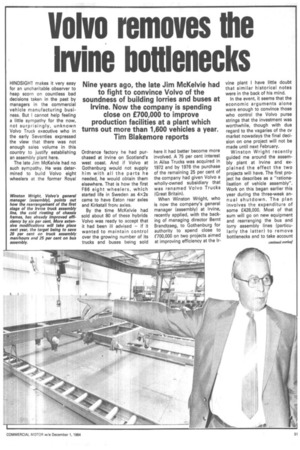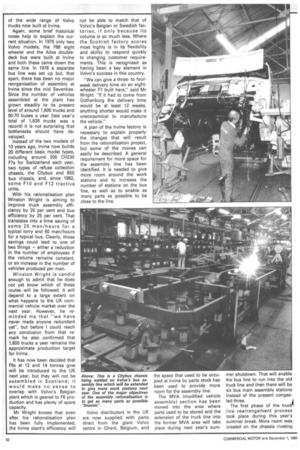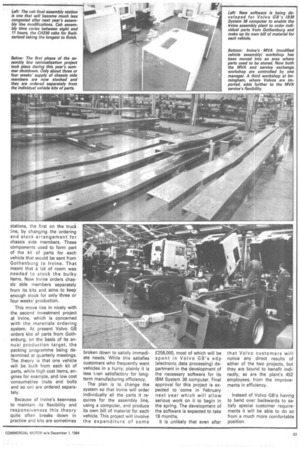Volvo removes the Irvine bottlenecks
Page 53

Page 54

Page 55

If you've noticed an error in this article please click here to report it so we can fix it.
HINDSIGHT makes it very easy for an uncharitable observer to heap scorn on countless bad decisions taken in the past by managers in the commercial vehicle manufacturing business. But I cannot help feeling a little sympathy for the now, not surprisingly, unknown Volvo Truck executive who in the early Seventies expressed the view that there was not enough sales volume in this country to justify establishing an assembly plant here.
The late Jim McKelvie had no such sympathy. He was determined to build Volvo eight wheelers at the former Royal Ordnance factory he had purchased at Irvine on Scotland's west coast. And if Volvo at Gothenburg would not supply him with all the parts he needed, he would obtain them elsewhere. That is how the first F86 eight wheelers, which started life in Sweden as 4x2s came to have Eaton rear axles and Kirkstall front axles.
By the time McKelvie had sold about 80 of these hybrids Volvo was ready to accept that it had been ill advised — if it wanted to maintain control over the growing number of its trucks and buses being sold here it had better become more involved. A 75 per cent interest in AiIse Trucks was acquired in 1972 and by 1976 the purchase of the remaining 25 per cent of the company had given Volvo a wholly-owned subsidiary that was renamed Volvo Trucks (Great Britain).
When Winston Wright, who is now the company's general manager (assembly) at Irvine, recently applied, with the backing of managing director Bernt Brandtzaeg, to Gothenburg for authority to spend close to £700,000 on two projects aimed at improving efficiency at the Ir vine plant I have little doubt that similar historical notes were in the back of his mind.
In the event, it seems that the economic arguments alone were enough to convince those who control the Volvo purse strings that the investment was worthwhile, though with due regard to the vagaries of the cv market nowadays the final decision on one project will not be made until next February.
Winston Wright recently guided me around the assembly plant at Irvine and explained the effect the two projects will have. The first project he describes as a "rationalisation of vehicle assembly". Work on this began earlier this year during the three-week annual shutdown. The plan involves the expenditure of some £428,000. Most of that sum will go on new equipment and rearranging the bus and lorry assembly lines (particularly the latter) to remove bottlenecks and to take account of the wide range of Volvo trucks now built at Irvine.
Again, some brief historical notes help to explain the current situation. In 1975 only two Volvo models, the F86 eight wheeler and the AiIse doubledeck bus were built at Irvine and both these came down the same line. In 1978 a separate bus line was set up but, that apart, there has been no major reorganisation of assembly at Irvine since the mid Seventies. Since the number of vehicles assembled at the plant has grown steadily to its present level of around 1,600 trucks and 60-70 buses a year (last year's total of 1,639 trucks was a record) it is not surprising that bottlenecks should have developed. Instead of the two models of 10 years ago, Irvine now builds 20 different basic model types, including around 200 CH230 F7s for Switzerland each year, two types of refuse collection chassis, the Citybus and B55 bus chassis, and, since 1982,. some F10 and F12 tractive units.
With his rationalisation plan Winston Wright is aiming to improve truck assembly efficiency by 20 per cent and bus efficiency by 25 per cent. That translates into a time saving of some 20 man/hours for a typical lorry and 50 man/hours for a typical bus. Clearly, those savings could lead to one of two things — either a reduction in the number of employees if the volume remains constant, or an increase in the number of vehicles produced per man.
Winston Wright is candid enough to admit that he does not yet know which of these routes will be followed. It will depend to a large extent on what happens to the UK commercial vehicle market over the next year. However, he reminded me that "we have never made anyone redundant yet", but before I could reach any conclusion from that remark he also confirmed that 1,600 trucks a year remains the approximate production target for Irvine.
It has now been decided that F6s at 12 and 14 tonnes gvw will be introduced to the UK next year, but they will not be assembled in Scotland; it would make no sense to overlap with Volvo's Belgian plant which is geared to F6 production and has plenty of spare capacity.
Mr Wright knows that even after his rationalisation plan has been fully implemented, the Irvine olant's efficiency will not be able to match that of Volvo's Belgian or Swedish factories, if only because its volume is so much less. Where the Scottish factory scores most highly is in its flexibility and ability to respond quickly to changing customer requirements. This is recognised as having been a key element in Volvo's success in this country.
"We can give a threeto fourweek delivery time on an eightwheeler F7 built here," said Mr Wright. "If it had to come from Gothenburg the delivery time would be at least 12 weeks, anything shorter would make it uneco9omical to manufacture the vehicle."
A plan of the Irvine factory is necessary to explain properly the changes that will result from the rationalisation project, but some of the moves can easily be described. A general requirement for more space for the assembly line has been identified. It is needed to give more room around the work stations and to increase the number of stations on the bus line, as well as to enable as many parts as possible to be close to the line.
Volvo distributors in the UK are now supplied with parts direct from the giant Volvo centre in Ghent, Belgium, and the space that used to be occupied at Irvine by parts stock has been used to provide more room for the assembly line.
The MVA (modified vehicle assembly) section has been moved into the area where parts used to be stored and the extension of the truck line into the former MVA area will take place during next year's sum
mer shutdown. That will enable the bus line to run into the old truck line and then there will be six bus main assembly stations instead of the present congested three.
The first phase of the truck' line rearrangement process took place during this year's summer break. More room was created on the chassis riveting stations, the first on the truck iine, by changing the ordering and stock arrangement for chassis side members. These components used to form part of the kit of parts for each vehicle that would be sent from Gothenburg to Irvine. That meant that a lot of room was Deeded to stock the bulky items. Now Irvine orders chassis side members separately from its kits and aims to keep enough stock for only three or four weeks' production.
This move ties in nicely with the second investment project at Irvine, which is concerned with the materials ordering system. At present Volvo GB orders kits of parts from Gothenburg, on the basis of its annual production target, the packing programme being determined at quarterly meetings. The theory is that one vehicle will be built from each kit of parts, while high cost items, engines for example, and low cost consumables (nuts and bolts and so on) are ordered separately.
Because of Irvine's keenness to maintain its flexibility and responsiveness this theory quite often breaks down in practice and kits are sometimes broken down to satisfy immediate needs. While this satisfies customers who frequently want vehicles in a hurry, plainly it is less elan satisfactory for longterm manufacturing efficiency.
The plan is to change the system so that Irvine will order individually all the parts it requires for the assembly line, using a computer, and produce its own bill of material for each vehicle. This project will involve the expenditure of some £258,000, most of which will be spent in Volvo GB's edp {electronic data processing) department in the development of the necessary software for its IBM System 38 computer. Final approval for this project is expected to come in February next year which will allow serious work on it to begin in the spring, The development of the software is expected to take 18 months.
It is unlikely that even after that Volvo customers will notice any direct results of either of the two projects, but they are bound to benefit indirectly, as are the plant's 452 employees, from the improvements in efficiency.
Instead of Volvo GB's having to bend over backwards to satisfy special customer requirements it will be able to do so from a much more comfortable position.




























































































